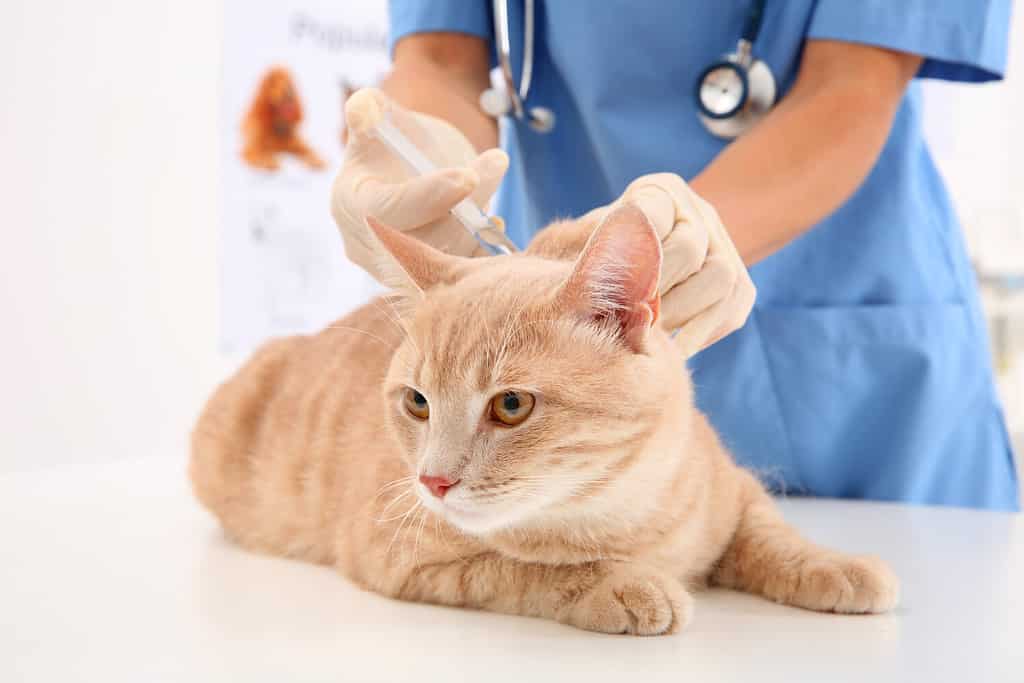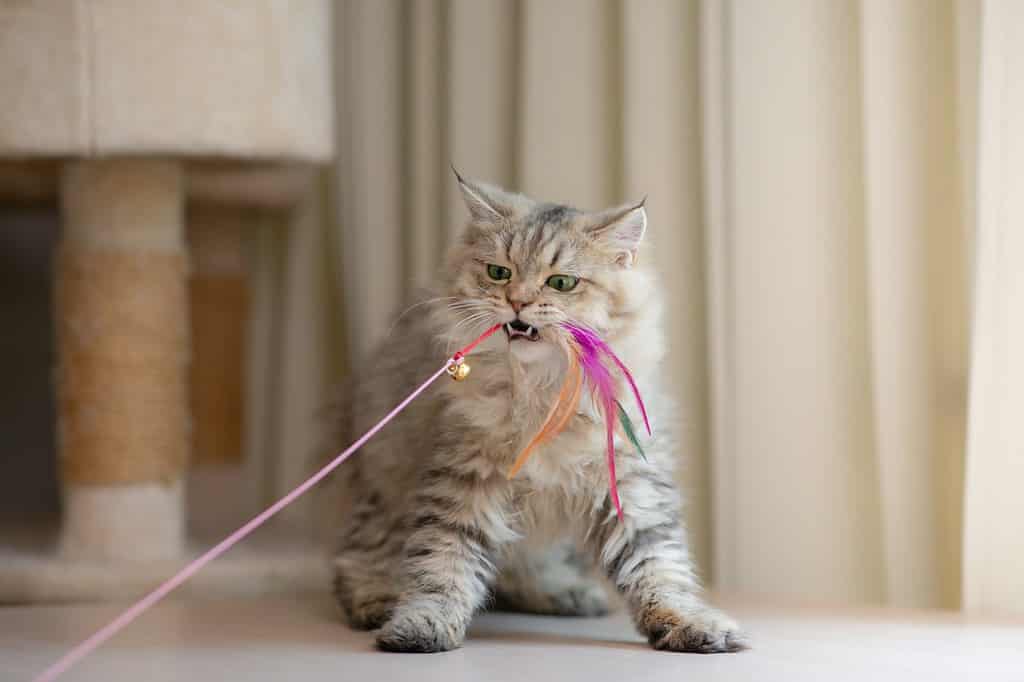When a loved one chokes, it’s terrifying. Often, our first reaction is to freeze or panic, but knowing what to do in advance of these scary times is essential so you can save your loved one’s life. Here’s what to do if your cat is choking.
Overall, there are three main steps you can try. Mouth sweeping, back-slapping, and the Heimlich maneuver, which sounds technical but really isn’t. You can easily perform this lifesaving action.
But first, how do you know if your cat is choking? What are the signs of choking?
Choking Cat Signs

A choking cat will claw its mouth, gag, and show signs of panic.
©I Wei Huang/Shutterstock.com
If your cat has a blocked airway, they may display one or many of the following signs:
- Panic
- Clawing at mouth
- Gagging and retching
- Scooting backwards
- Back and neck arching
- Staggering and falling
- Rasping and wheezing
After immediate choking, your cat may collapse, develop blue gums, or fall unconscious.
What To Do If Your Cat Is Choking

If there’s time, wrap your choking cat in a blanket so they can’t scratch or escape.
©iStock.com/ElenaBoronina
It’s scary for sure, but the first step in saving your cat’s life is:
Don’t panic.
Then, grab the nearest tea towel, sofa throw, or item of clothing to wrap your cat in so you can help without their claws preventing assistance. Even if your cat has never laid a claw on you in the past, in this emergency situation they may lash out.
You could also shout to whoever else is in the house for help.
First Step: Mouth Sweep

Sweep your cat’s mouth with an index finger, but be careful you don’t push an object further down.
©Sheila Fitzgerald/Shutterstock.com
Kneel on the floor with your cat between your knees. Then, gently but firmly, open your cat’s mouth and look inside. If you can see the obstruction, remove it. If you can’t, then gently sweep your index finger around their mouth. Hold their tongue and pull it forward to reveal hidden obstructions.
Do not poke your finger down, as this could push a blockage even further in.
This is often enough to spot a foreign object. When you pull on the object, resist the urge to yank it out, as this may leave pieces behind. Gently pull the obstruction forward until it’s clear. Then check for more.
If you cannot see anything, or you can’t do a mouth sweep, move on the Heimlich maneuver.
Second Step: Kitty Heimlich Maneuver

A Heimlich maneuver forces out trapped air to expel a blockage.
©LightField Studios/Shutterstock.com
Pick up your cat so she is facing forward with her back against your abdomen or chest. Hold her under the front legs and leave her back legs dangling down. Use one hand or your forearm so your dominant hand is free.
Place your hand on her belly at the top in the soft hollow where the ribs meet the tummy. Form a fist and pull in and upwards sharply five times. These thrusts expel air trapped beneath the blockage and blow the object out.
If it’s easier for you and your cat to comply, use both hands to carry out the series of sharp upward thrusts.
After performing the Heimlich maneuver, hang your cat forward and perform another mouth sweep.
Still nothing?
Don’t panic, try again or move to the third step:
Third Step: Back Slaps
Hold your cat by her hips so her head is dangling groundward. Open your palm, and pat or slap her back five times. Then try another mouth sweep. If the item is still lodged, try another five back slaps.
Don’t give up. Each back slap, sharp upward thrust, or mouth sweep can move the object forward. If the blockage just won’t shift, head straight to your nearest veterinarian.
Steps To Take After Your Cat Choked

After a choking episode, it’s best to have your cat checked over by a veterinarian.
©Africa Studio/Shutterstock.com
Once the blockage is clear, your cat will start to breathe normally again, and the choking signs will stop. Don’t let her run off because it’s important to assess her behavior.
If her gums don’t return to pink, she’s unable to stand or walk normally, she’s collapsed, or just not behaving her usual self, speak to your vet as soon as possible.
Lack of oxygen to the brain can cause temporary or lasting symptoms, so it’s best to get checked. The blockage or Heimlich maneuver may have caused damage, too. Don’t feel bad if your efforts to remove the blockage caused bruising or injury, without them your cat may not have survived.
Besides this, your cat may feel exhausted, scared, and disorientated, so inside your home is the safest place for her.
What To Do If Your Kitten is Choking
If your small cat or kitten is choking, follow the above steps but with a gentler hand. If you need to perform the kitty Heimlich, use two fingers for sharp upward thrusts rather than your whole hand.
What Can Cats Choke On?

Cat toys with feathers and loose fabrics create a choking hazard.
©ANURAK PONGPATIMET/Shutterstock.com
It’s tempting to think that hunter cats can easily eat fur, feathers, bones, and beaks. In some cases, they can, but not always.
Cat Toys
Not all cat toys are equal, in fact, some are just dangerous.
Toys with loose feathers, googly eyes, and long fabric tails may work loose and choke your cat. Small toys can pose problems too, for example, tiny catnip mice that cats can swallow whole. If your cat is a fish pole toy lover, play with her, but tidy away the toy afterward so she can’t access it unsupervised.
The safest cat toys include toy mice at least two inches long by an inch wide, without loose pieces, balls with holes, and crumpled-up pieces of paper.
Bones
Cats choke on bones, even small and flexible fish bones, so you should never give your cat bone-filled food. As well as the choking risk, a bone may tear the mouth, throat, or stomach and lead to emergency surgery (and very expensive vet bills).
Furballs
Most cats hack up furballs now and then. It’s a natural process that rids your feline friend of consumed fur, feathers, and bone fragments. Swallowed coat hair also creates furballs, so your indoor cat is not immune!
However, if your cat brings up a hairball frequently or coughs and hacks regularly but no hairball emerges, it’s best to see your veterinarian. Trapped furballs can block a cat’s digestive tract and cause a multitude of medical problems. Your vet may suggest furball-specific food or medicine to help her get rid of the mass.
On occasion, a cat may gag or display choking signs when they aren’t choking. This could be a symptom of rare cat asthma, a gastrointestinal problem, or a chest infection. Again, it’s best to seek medical advice before the problem gathers pace.
So, if your cat is choking, here’s what to do in a quick-action rundown:
- Don’t panic
- Wrap your cat if there’s something to hand
- Mouth sweep
- Kitty Heimlich – five sharp upward thrusts in the soft bit between her ribs and belly
- Back slaps – dangle her body downward and firmly slap her back
- Once dislodged, monitor her behavior and/or see a veterinarian

Indoor cats can develop fur balls from loose hair.
©Bogdan Kurylo/iStock via Getty Images
The photo featured at the top of this post is © Ivan Murauyou/iStock via Getty Images
Thank you for reading! Have some feedback for us? Contact the AZ Animals editorial team.







